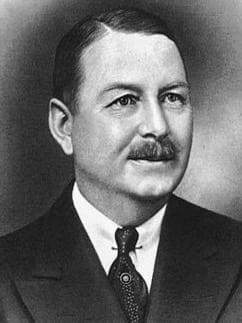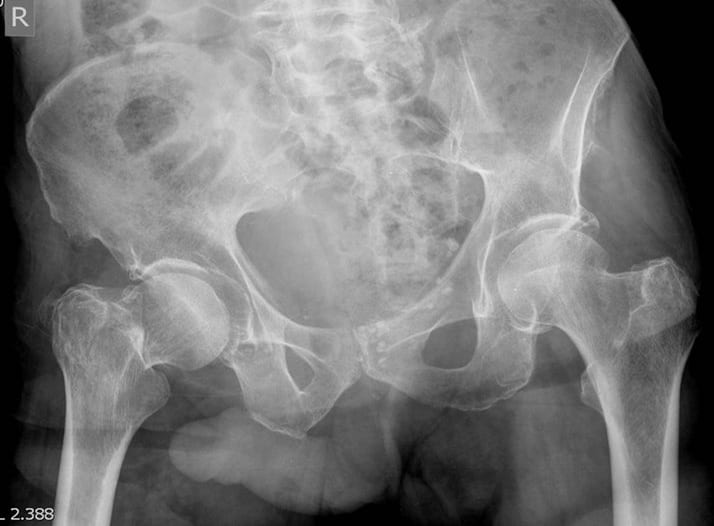Tom Throckmorton
Thomas Bentley Throckmorton (1885-1961) was an American neurologist
Tom’s life was dedicated to fundamental Christian values and toward betterment of the profession he dearly loved. In his 50 years of practice, he never refused a patient who could not pay. Many were down and out, and were befriended in addition to being treated for their physical ills. He gave untold hours to organized medicine, without thought of personal aggrandizement, in an effort to raise the ethical standards of the profession he loved
Throckmorton is remembered for describing the Throckmorton reflex. He is also the namesake of the Throckmorton sign used in radiology. Throckmorton also gave a simple method for recognizing motor paralysis of the lower extremities
Biography
- Born January 20, 1885 in Derby, Iowa
- 1907 – BS, Simpson College
- 1909 – Doctorate in medicine Jefferson Medical College in Philadelphia; Dercum Gold medal in Neurology
- 1909-1911 Worked at the Maplewood Sanatorium (house physician); Philadelphia Orthopedic Hospital (resident physician); Infirmary for Nervous Diseases in Philadelphia (resident physician); and the Cherokee State Hospital for the Insane (assistant physician)
- 1912-1913 Lecturer in neurology, Drake Medical College
- 1916-1930 Secretary, Iowa State Medical Society
- 1920-1928 Governor of the Iowa Chapter of the American College of Physicians; Secretary and Trustee of the Interstate Postgraduate Medical Association of North America
- 1936 – Grand Master of Masons in Iowa
- 1952 – President Polk County Medical Society
- Died on July 4, 1961
Medical Eponyms
Throckmorton sign (John Thomas sign)
This sign can only be found in males – a patient has a positive Throckmorton sign if his penis points towards the side of pathology on a radiograph of the pelvis.
Throckmorton reflex (1911)
Variation of the Babinski reflex elicited by percussion of the metatarsophalangeal region on the dorsum of the foot.
The extensor plantar reflex, to which Babinski first called attention in 1898, and which bears his name, is considered by neurologists as being the most important reflex at their command by which to differentiate between functional and organic nerve lesions.
Babinski has shown that normally when the sole of the foot is stimulated by drawing some foreign object across its surface, plantar flexion of the toes follows; whereas, in organic diseases of the nervous system, particularly in spinal cord diseases accompanied by spastic symptoms, instead of a plantar flexion of the toes, an extension of the digits occurs which is most noticeable in the great toe and which acts more slowly than does the normal flexion.
I found that the extensor toe reflex could also be obtained in a manner different from any of the above mentioned ways. In every case in which the Babinski sign was present percussion at the base of the great toe would produce extension of this member, accompanied some times by extension of the remaining digits.
The skin overlying the upper surface of the first metatarsophalangeal articulation is struck with the pointed end of a percussion hammer just to the inner side of the tendon of the extensor longus hallucis muscle…to produce extension of the toe…it is always considered pathologic except in infants, in whom the pyramidal tracts have not been developed, and in those cases of spinomuscular lesion in which the plantar flexor muscles alone are involved
Throckmorton 1911

Major Publications
- Throckmorton TB. A new method for eliciting the extensor toe reflex. JAMA. 1911; 26(18): 1311-1312. [Throckmorton reflex]
- Throckmorton TB. The role of extensor toe reflex in neurological diagnosis. New York Medical Journal, 1911, 94: 786-787. [Throckmorton reflex]
- Throckmorton TB. A simple method for demonstrating motor paralysis of the lower extremities with special reference to Hoover’s sign. JAMA. 1923;80(15):1058-1060
- Throckmorton TB. The history of medicine in Lucas County. 1934
- Throckmorton TB. Francis X Dercum: physician teacher and philosopher. J Nerv Ment Dis 1942; 96: 529–541.
- Throckmorton TB. Medicine then and now. Journal of the Iowa State Medical Society 1961; 51(2): 109-118
References
Biography
- Dr Tom Bentley Throckmorton. Journal of the Iowa State Medical Society. 1933; 23(10): 591
- Glomset DA. Dr Tom Bentley Throckmorton. Journal of the Iowa State Medical Society 1961; 51(10): 671
- History of Lucas County, Iowa. Walsworth Publishing Company, Inc. 1978; 300
- Bibliography. Throckmorton, Tom Bentley. WorldCat Identities
Eponymous signs
- Foley R. Throckmorton sign (pelvis). Radiopaedia
- Cadogan M. Throckmorton sign. Eponym A Day, Instagram
[cite]


